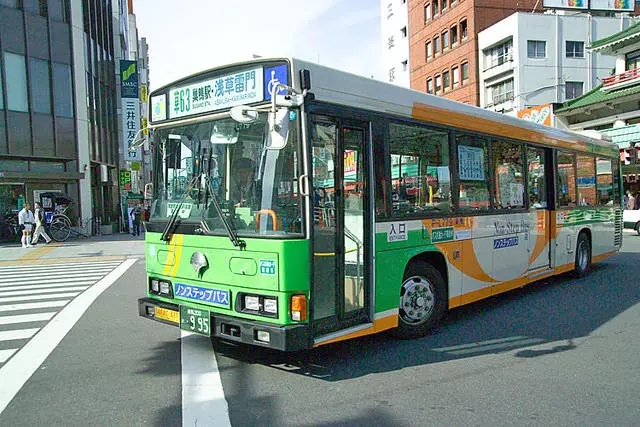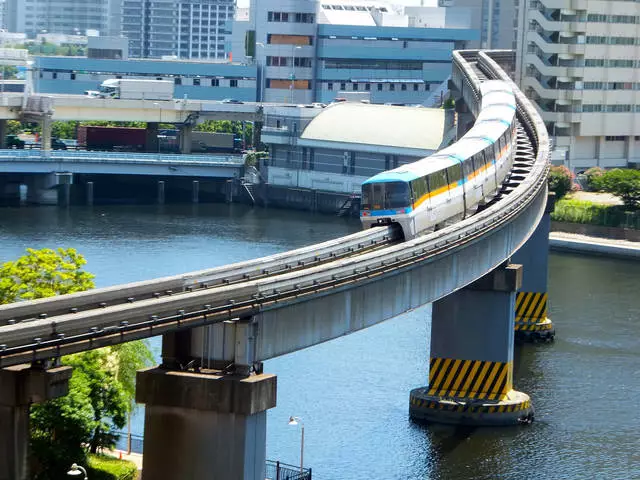In Tokyo, you can move on a different transport, the benefit of this megalopolis offers many options - the metro, trains (monorails, suburban), buses and omnipresent taxis. In each quarter, Tokyo is equipped with stopping of urban transport, so that it takes no more than fifteen minutes to come to the nearest to you. The name of any station is written not only in Japanese, but also in English.
Buses
Tokyo buses are not very popular among local residents. I would not call this type of transport convenient due to the complexity of the system We, because on some routes there are private traders, others are under the control of the city authorities, and all different prices for travel - it happens that on the same route the fare is different. Bus routes are mostly short - From one metro station to another. You need to pay for travel when leaving the transport. Travel day worth five hundred yen, and on a one-time trip - two hundred . Buses come out on the line from seven in the morning and end the delivery of passengers at nine in the evening.

Trams
Ride at the local tram will cost 160 yen . Travel for a whole day can be bought for 400. . Tokyo has been left in Tokyo One tram line Although half a century ago there were more than forty. Manages transportation on this single 12-kilometer line Company "TOEI" . The compositions go every 15 minutes. The passage is paid at exit, with the help of a special machine installed near the driver's workplace.
Trains
In Japan with unthinkable for our person, speeds of 200-300 kilometers per hour "fly" Pullets "Sinkansen" . On such a miracle transport from Tokyo, you can reach the suburbs - Kyoto, Nagoya, Kobe, Osaka, Hiroshima and to Cussy Island. These trains are departed with Tokyo Main Railway Station.
In addition to high-speed trains, the suburbs run Electrics . Not so long ago, transportation was opened in the direction "Tokyo-Nogano". Electric trains that walk along the line Toshoku (Sendai and Morioka) arrive to the station of the Wen in the north of the main railway station. In addition, the Weno train station also arrives from Niigata. Transportation on Matsumoto leaves from the Stanzuka station.
On different lines, the wagons of the compositions are painted in their own way: for example, on a 35-kilometer line Yamanoth E, built by a ring around the city's central part, they are green or silver with green stripes; on the line Choo , crossing the Japanese capital from East to West, to the suburbs of Takao - Orange. In the center of Tokyo there is another line - Sob . She is yellow. From the north to the south, the blue, it is called Keyikhin Tohok.

The compositions that run through the Ring Line of Jamanoteau pass the whole way for an hour, selecting and disembarking passengers from 29 stations, including important transport hubs - "Yurakucho", "Shinbashi", "Shinagawa", "Shibuya", "Shinjuku "And" Ueno ".
Trains of green and yellow lines ("Yamanotele" and "soba", respectively) go from 04:30 to 00:30. The largest passenger traffic is from 07:00 to 09:30 and from 17:00 to 19:00.
Minimum fare in Tokyo Train - 160 yen . The amount can be determined by a special table, which is located on large stands, which are equipped with all stations. Everything is not so difficult here, given the plus that the names of the stations are designated both in Japanese and in English. In the event that even you will not be able to decide on the train, there is such a way out: buy the cheapest ticket, and the missing amount pay extra at the exit When you return a ticket. I hope out of the foregoing you already clear that Tickets are stored until the end of the trip. Another important point: Direct valid only on the day of purchase.
Monorail
Monorail lines appeared in the capital of Japan for a very long time - in the middle of the last century, or rather - in 1957. There are several of them in Tokyo. Monsorels formulations move automatically, without machinists. At the same time, the location of the train relative to the monorail is different - and on top, and under it.
Monorail works in itself, autonomously, with its own stations and without crossing the Lines of JR trains. Tickets for this type of transport, respectively, also differ from travel on a regular train. The fare on different lines is different, because they are managed by various carriers.
The western part of the city is served by 16-kilometer monorail line "Tama Toshi Monorail Line" . It is nineteen stations. Using two lines "Chiba Urban Monorai L »You can get to the suburbs of Tokyo - Cyba city. On this monorace, too, 19 stations. Look for more information on the carrier's website: http://chiba-monoraail.co.jp..
Handed Airport is connected to the city with MONORELS "Tokyo Monorail" . Station is located right at the airport "HANEDA AIRPORT TERMINAL 2 STATION", With which this line begins, going to Tokyo itself and reaching almost 18 kilometers long. Here they run the compositions of three different species - Express, fast and usual . With the map and the train schedule, you can find the site on this line, here it is: http://www.tokyo-monoraail.co.jp/english/.

Travel on Tokyo Monorail is at least 150 ya n. Travel can be bought at any country and large station airports.
Metropolitan.
The local metro in magnitude ranks third in the world ranking. For the first time, the metro in Tokyo (and in all Asia) was opened in the distant 1927, today this transport subsystem has Thirteen lines . Manage Tokyo metro two offices - Private "Tokyo Met.ro " controlling nine lines and State "TOEI" under the control of which are the remaining four.
Transfer Between lines Provides the purchase of a passenger New ticket . The only exception is if you use electronic transport card "Pasmo».
Train interval - five minutes. They run on lines from five in the morning until midnight. Different branches on the cards are painted in the corresponding colors. The stations are announced in two languages - English and Japanese.
Also, as in the case of trains, the fare is determined by a special card scheme. The stations on them are denoted by the combinations of the "letter + digit". The letter indicates a line, the number is the sequence number of the station. Nearby you can see the fare to the storage station. The cheapest tickets on Tokyo Metro lines are 160 yen, and on "TOEI" -170.
